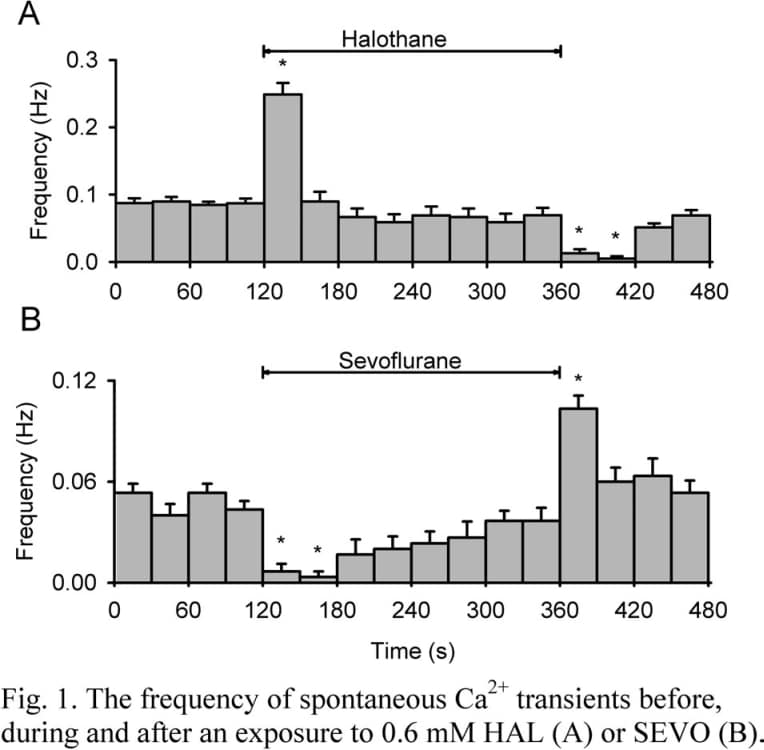In electrically stimulated myocytes, halothane (HAL) causes an initial positive, followed by a sustained negative inotropic effect and upon removal, contractility transiently falls further before returning to control. In contrast, isoflurane (ISO) and sevoflurane (SEVO) initially decrease contractility (more marked with equimolar SEVO), which then returns towards control and upon removal, contractions increase above control (more pronounced with equimolar SEVO) before returning to pre-anaesthetic levels (Davies et al., 2000). HAL has been reported to sensitize Ca2+ release from the sarcoplasmic reticulum (SR; Wheeler et al., 1997) which may contribute to its positive inotropic effect. The Aim of these experiments was to compare the effect of equimolar HAL, ISO and SEVO on the sensitivity of the SR Ca2+ release process to determine its role in the inotropic profiles of the three anaesthetics. Wistar rats (200-250 g) were killed humanely (schedule 1), the heart removed and ventricular myocytes isolated by enzymatic dispersion. Intracellular Ca2+ was recorded optically (fura-2) in unstimulated cells superfused with a Tyrode solution containing 2 mM Ca2+ and exposed to 0.6 mM anaesthetic for 4 min at 30 °C. The frequency and amplitude of spontaneous Ca2+ release was expressed as an average of events during periods of 30 s. Data are mean ± SEM (n=9-13) and statistical significance determined using repeated measures ANOVA. In the first 30 s HAL increased the frequency of spontaneous Ca2+ release (from 0.09 ± 0.01 to 0.25 ± 0.02 Hz; P<0.05) which then returned to control levels (Fig. 1A) accompanied by a decline in transient amplitude; after a 4 min exposure, amplitude was reduced to 49% of control. Removal of HAL restored transient amplitude but frequency was further reduced (to 0.01 ± 0.01 Hz; P<0.05) for 60 s before returning to control. During the first 60 s of exposure to SEVO the frequency was significantly reduced (from 0.05 ± 0.01 to 0.004 ± 0.003 Hz, P<0.05) but returned to control during the exposure (Fig. 1B). Removal of SEVO significantly increased frequency (to 0.10 ± 0.01 Hz, P<0.05) before returning to control over the next 30 s. No significant changes in the amplitude of spontaneous Ca2+ transients were observed during or after exposure to SEVO. ISO had no significant effects on either frequency or amplitude of spontaneous Ca2+ release.These data suggest that changes in the sensitivity of the SR Ca2+ release process contribute to the positive and negative inotropic actions of HAL and SEVO but not ISO.
University of Glasgow (2004) J Physiol 557P, PC4
Communications: Comparative effects of halothane, isoflurane and sevoflurane on spontaneous Ca2+ release in rat ventricular myocytes
M. Graham (a),G.Bru-Mercier (a),P.Hopkins (b) and S. Harrison (a)
(a)School of Biomedical Sciences, University of Leeds, Leeds, UK and (b) Academic Unit of Anaesthesia, University of Leeds, Leeds, UK
View other abstracts by:
Where applicable, experiments conform with Society ethical requirements.

